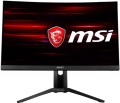Colour depth
The colour depth supported by the monitor.
This parameter characterizes the number of shades that the screen can display. And here it is worth recalling that the image in modern monitors is based on 3 basic colours — red, green, blue (RGB scheme). And the number of bits is indicated not for the entire screen, but for each base colour. For example, 6 bits (the minimum colour depth for modern monitors) means that the screen is capable of producing 2 ^ 6, that is, 64 shades of red, green and blue; the total number of shades will be 64 * 64 * 64 = 262,144 (0.26 million). An
8-bit colour depth (256 shades for each base colour) already gives a total of 16.7 million colours; and the most advanced modern monitors support
10-bit colour, allowing you to work with more than a billion shades.
Screens with support for FRC technology are worth a special mention; nowadays, you can find models marked "
6 bit + FRC " and "
8 bit + FRC ". This technology was developed to improve picture quality in situations where the incoming video signal has a greater colour depth than the screen, such as when 10-bit video is fed to an 8-bit matrix. If such a screen supports FRC, the picture on it will be noticeably better than on a regular 8-bit monitor (although somewhat worse than on a full-fledged 10-bit monitor, but “8 bit + FRC” screens are much
...cheaper).
High colour depth is important primarily for professional graphics and other tasks that require high colour fidelity. On the other hand, such features significantly affect the cost of the monitor. In addition, it is worth remembering that the quality of colour reproduction depends not only on the colour depth, but also on other parameters — in particular, colour gamut (see below).Height adjustment
The ability to move the monitor screen up and down relative to the base. This feature is very convenient for
adjusting the height of the screen — moving it on the mount is much easier than looking for a stand or resorting to other tricks.
Game Features
—
Aim. The ability to display crosshairs on the screen (usually in the centre) — moreover, due to the operation of the monitor itself, regardless of the game settings. This feature can be useful in some "shooters" — for example, if the game itself does not have a traditional crosshair and accurate shooting is possible only when using sights on weapons, or if some types of weapons do not provide crosshairs at all. On many monitors, the shape and/or colour of the crosshairs can be selected from several options.
—
Timer. Possibility to display time counter on the screen. This feature is designed mainly for real-time strategy, although it can be useful in other cases — for example, if a gamer tends to get carried away and forget that you need to stop the game in time. Usually, the timer scale is made translucent — this provides good visibility and at the same time does not interfere with the process.
—
FPS display. The ability to display the current frame rate on the monitor right during the game. This function allows you to control the load on the video adapter and makes it easier to select the optimal detail settings so that the game does not turn into a “slideshow” and at the same time the picture remains more or less high-quality. Note that the ability to display FPS is available in some games, but for a full guarantee it is better to have such a tool
...in the monitor itself.
— Highlighting dark areas. A function that allows you to increase the brightness of certain dark areas on the screen without "highlighting" the rest of the image. One of the most popular ways to use this feature is to detect enemies hiding in dark places.RGB lighting
Availability in the monitor of external backlight RGB.
Such lighting is in the form of LEDs or LED strips embedded in the frame and/or back panel. It performs mainly a decorative function — it gives the monitor an interesting appearance, which is especially appreciated by gamers and modding enthusiasts. The abbreviation RGB means that the backlight can change colour; at the same time, the matter is usually not limited to three basic colours (red-green-blue — red-green-blue), lighting can take on almost any shade. In some models, it can even automatically adjust to the image on the screen — in such a way that the backlight visible to the user improves the overall impression of the picture. There are also backlight systems that can synchronize with other system components (see below for more details).
RGB lighting sync
The timing technology provided by the RGB backlit monitor (see above).
Synchronization allows you to "match" the backlight of the monitor with the backlight of other system components — the case, its hardware (motherboard, processor, graphics card), keyboard, mouse, etc. Thanks to this matching, all components can change colour synchronously, turn on / off at the same time etc. The specific features of the operation of such a backlight depend on the synchronization technology used, and, usually, each manufacturer has its own (Aura Sync for Asus, RGB Fusion for Gigabyte, etc.). The compatibility of the components also depends on this: they must all support the same technology. So the easiest way to achieve backlight compatibility is to collect components from the same manufacturer.

